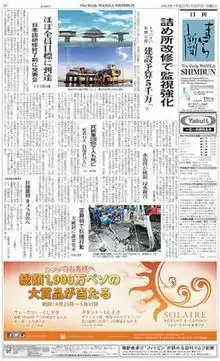Manila Shimbun
The Manila Shimbun (まにら新聞), officially called The Daily Manila Shimbun (日刊まにら新聞, Nikkan Manira Shinbun), is a daily broadsheet newspaper in the Philippines written in the Japanese language. Established in May 1992, it is Southeast Asia's first modern-day daily Japanese-language newspaper.[1] Although the newspaper is primarily in Japanese, it also has a section in English.
 The front page of the Manila Shimbun on March 27, 2013 | |
| Type | Daily newspaper |
|---|---|
| Format | Broadsheet |
| Owner(s) | TAKION, Inc. |
| Managing editor | 横山 立 Eiichiro Ishiyama, Ritsu Yokoyama |
| Founded | May 1992[1] |
| Political alignment | Independent |
| Language | Japanese (primary) English (secondary) |
| Headquarters | Makati, Metro Manila, Philippines |
| Website | www |
The newspaper and its journalists have won several awards for its news articles or other works based on their experiences while on assignment. It has won several awards from the Association of Nikkei and Japanese Abroad, including two grand prizes in 2004 and 2007,[1] while a journalist for the newspaper, Takehide Mizutani, won the Takeshi Kaikō Prize in 2011 for his book The Men Who Abandoned Japan (日本を捨てた男たち), inspired by the homeless Japanese he met in the Philippines as a journalist.[2] The newspaper also has a history of community outreach, particularly to non-Japanese-speaking Filipinos, through the Daily Manila Shimbun Culture Center. It began organizing an annual cooking festival in 1998,[3] as well as a Filipino-language essay writing contest in 2002.[4] In 2014, the newspaper signed a memorandum of agreement with the Tourism Promotions Board, an attached agency of the Department of Tourism, to promote Japanese tourism to the Philippines through media placements both in the Manila Shimbun and its sister magazines.[5]
The Manila Shimbun also refers to an unrelated World War II-era newspaper published by the Manila Shimbunsha (マニラ新聞社), which held a monopoly on all wartime print information dissemination for propaganda purposes, including control over the pre-war outlets that were allowed to remain open.[6]
References
- "まにら新聞について". まにら新聞ウェブ (The Daily Manila Shimbun Web). Asian International Community Information, Inc. Retrieved July 2, 2016.
- Brasor, Philip (November 30, 2013). "Philippines typhoon coverage skirts over tales of 'the men who abandoned Japan'". The Japan Times. The Japan Times, Ltd. Retrieved July 2, 2016.
- Castillo, Lydia D. (September 2, 2001). "Pinoy Nouvelle Cuisine". The Philippine Star. PhilStar Daily, Inc. Retrieved July 2, 2016.
- Nacuspad, Rey B. (February 6, 2002). "Filipino short story contest". Manila Standard. Kamahalan Publishing Corporation. Retrieved July 2, 2016 – via Google News.
- Gatdula, Donnabelle L. (February 1, 2014). "DOT pushes tourism promo in Japan via media tieups". The Philippine Star. PhilStar Daily, Inc. Retrieved July 2, 2016.
- Kintanar, Thelma B.; Aquino, Clemen C.; Arinto, Patricia B.; Camagay, Ma. Luisa T. (2006). Kuwentong Bayan: Noong Panahon ng Hapon : Everyday Life in a Time of War. Quezon City: University of the Philippines Press. p. 164. ISBN 971-542-498-8.